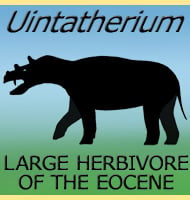Uintatherium
In Depth Imagine a rhinoceros with several smaller horns on top of its head and forward teeth similar to a sabre-toothed cat and you have a rough idea to what Uintatherium looked like. Although first named by Joseph Leidy in 1872, Uintatherium would become involved in the ‘bone wars’, a well-publicised feud between the palaeontologists … Read more
